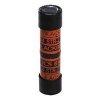Most people do not understand one of the characteristics of aluminum that makes it more problematic than copper for electrical connections. And that is how incredibly reactive aluminum really is.
We're all familiar with the way iron rusts (oxidizes) in the presence of humid air or oxygenated water. But most of us see aluminum used in various applications, and we never see any evidence of corrosion. So we tend to imagine that aluminum is very non-reactive and is resistant to oxidation.
But the truth is just the opposite! Aluminum is highly reactive and wants to oxidize very badly. But the interesting thing is that when aluminum oxidizes, the oxide that is formed is very inert.
Aluminum oxide is, in fact, sapphire! And sapphire is a great insulator. It's also clear, so we don't see it.

And ironically, that clear coating of sapphire protects the aluminum below it so in normal use, aluminum appears to be very corrosion-resistant. But it's that layer of corrosion on its surface that's protecting it!
So while aluminum isn't a terribly bad conductor (4th on the list, actually) the problem is that it's highly reactive, and the oxidation that forms is a fantastic insulator!
Bare aluminum exposed by scraping or sanding will oxidize over completely in 8 minutes or less in a normal atmosphere. In fact, aluminum is so reactive, so prone to oxidation, that fine aluminum powder is often used as the "fuel" in a number of explosive compositions. Look up "Tannerite" as an example that most of us have seen in use, if only on YouTube.
What has been found is that when aluminum is used at a contact point, the initial connection (screwing down a screw or mating an insulation displacement connector (IDC) may scrape through the oxide (sapphire) layer temporarily, and a good connection will appear to have been made.
But the reactivity of the aluminum is so strong that it will begin to oxidize, with the oxide burrowing down under the screw or below the contacts of the mated IDC connector, and eventually, the oxide will grow into the connection until the conductivity is made worse and worse.
The normal connectors used for these Ethernet cables are IDC types. That is, insulation displacement connectors. The way they work, when you crimp them onto the wire, is that a "fork" presses down so as to squeeze the insulation out of the way (thus the name: insulation displacement), and then the fork bites over the conductor inside, scraping it and squeezing down against it to form the electrical connection.
This connection relies on good conductivity of the tiny surfaces that are actually in contact.
Now, the idea of copper-clad aluminum is to provide a layer of copper over the aluminum so that the IDC (or other) connector bites onto copper instead of aluminum.
This sounds good, but because the copper plating is so thin, the actual cross sectional area of copper that is available to make contact with an IDC connector "fork" is extremely small. Further, the copper can be completely scraped away (penetrated) by the fork of the connector, and what results is a connection that again, relies on the aluminum making good contact to the connector fork.
And, as might be expected, oxygen can creep into the connection, and eventually oxidize the aluminum, leading to ever worsening contact.
Now, think about what causes electrical heating.
Heat is the product of current times voltage. Basically, power is heat.
As contact resistance rises, the voltage drop at the connection increases. Since the powered device still needs to consume its required power, and since the DC-DC converter in the powered device will simply draw more current to compensate for the lost voltage, the device will actually draw more current as the contact resistances increase, up to the limit of what the POE switch or injector can supply, or the limit of what the powered device's DC-DC converter can cope with.
So we have more and more heat being dissipated in the very tiny area where the connector's IDC contact forks are trying to make contact with the oxidized aluminum. And things spiral out of control.
This is why you can have fires start at the connection points when aluminum cable is used.
I don't have a lot of faith in these "modular" connectors anyhow. And when we start pushing power through them, I have even more concern. So the last thing I want to do is use aluminum cable, even if it's copper-clad.
And that doesn't even address the higher bulk resistance of aluminum versus copper.

